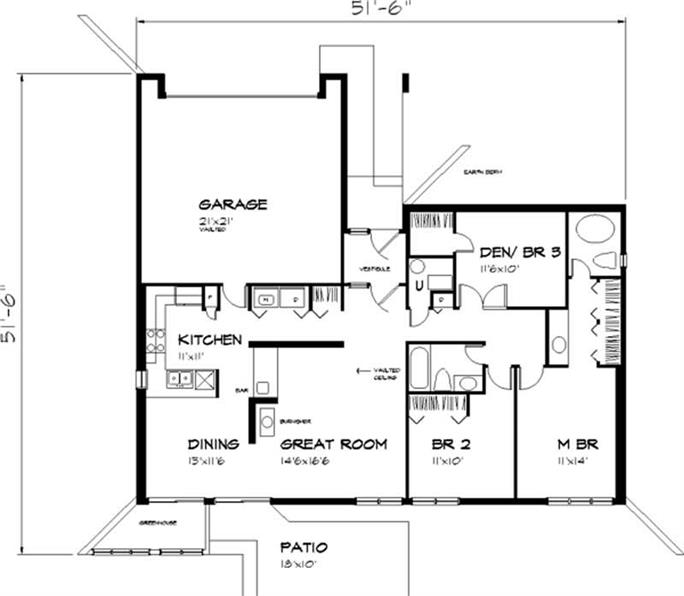Passive Solar Home Design Plans

Passive Solar Home Design Plans: A Comprehensive Guide
Passive solar home design is an architectural approach that harnesses the sun’s energy to heat and cool a building naturally, reducing reliance on conventional energy sources. This guide provides an in-depth exploration of passive solar home design plans, covering their definition, types, differences, advantages, and disadvantages.
Definition and Types of Passive Solar Home Design Plans
Passive solar home design plans prioritize the use of natural elements to create a comfortable indoor environment. They incorporate design strategies that maximize solar gain during the winter and minimize it during the summer.
Types of Passive Solar Home Design Plans:
- Direct Gain: Sunlight enters the home through south-facing windows and is absorbed by thermal mass materials, such as concrete or stone, which release heat into the space at night.
- Indirect Gain: Sunlight is collected by a thermal mass wall or floor, which then radiates heat into the home.
- Isolated Gain: Sunlight is collected in a separate space, such as a sunroom or greenhouse, and then transferred to the main living areas through thermal mass or convection.
Differences, Ease, and Process of Passive Solar Home Design Plans
Differences between Passive and Active Solar Design:
- Passive solar design relies solely on natural elements, while active solar design uses mechanical systems, such as solar panels, to collect and distribute solar energy.
- Passive solar design is typically more cost-effective and requires less maintenance than active solar design.
Ease of Implementation:
Passive solar home design can be integrated into new or existing homes, but it is more effective when incorporated into the initial design.
Process of Creating a Passive Solar Home Design Plan:
- Site Analysis: Determine the orientation of the home, shading, and surrounding landscape.
- Energy Modeling: Use computer simulations to predict the home’s energy performance and identify areas for improvement.
- Design Optimization: Incorporate passive solar design strategies, such as proper window placement, thermal mass, and insulation.
Advantages and Disadvantages of Passive Solar Home Design Plans
Advantages:
- Reduced Energy Costs: Passive solar design can significantly reduce heating and cooling costs.
- Improved Comfort: Passive solar homes maintain a more comfortable indoor temperature year-round.
- Environmental Sustainability: Passive solar design reduces greenhouse gas emissions by minimizing reliance on fossil fuels.
Disadvantages:
- Site Dependence: Passive solar design is most effective in areas with ample sunlight.
- Limited Control: Natural factors, such as weather and shading, can affect the performance of passive solar systems.
- Potential Overheating: Passive solar homes can overheat during the summer if not properly designed.
How to Design a Passive Solar Home
Key Considerations:
- Window Placement: South-facing windows maximize solar gain.
- Thermal Mass: Materials with high thermal mass, such as concrete or brick, absorb and release heat slowly.
- Insulation: Proper insulation prevents heat loss during the winter and heat gain during the summer.
- Shading: Overhangs, awnings, and trees can provide shade from the sun during the summer.
Step-by-Step Process:
- Determine the Home’s Orientation: Position the home to maximize solar exposure on the south side.
- Incorporate Thermal Mass: Use materials with high thermal mass in areas that receive direct sunlight.
- Provide Insulation: Install adequate insulation in walls, ceilings, and floors to minimize heat loss and gain.
- Control Solar Gain: Use shading devices to prevent overheating during the summer.
Conclusion
Passive solar home design plans offer a sustainable and cost-effective way to create comfortable and energy-efficient homes. By harnessing the sun’s energy, passive solar homes reduce reliance on fossil fuels, improve indoor comfort, and contribute to environmental sustainability.
FAQs
Q: What are the benefits of passive solar home design?
A: Passive solar home design reduces energy costs, improves comfort, and promotes environmental sustainability.
Q: How can I design a passive solar home?
A: Consider window placement, thermal mass, insulation, and shading devices to maximize solar gain and minimize heat loss.
Q: Are passive solar homes suitable for all climates?
A: Passive solar design is most effective in areas with ample sunlight, but it can be adapted to different climates.
Closing Statement
Passive solar home design is a valuable tool for architects and homeowners seeking to create sustainable and energy-efficient living spaces. By incorporating passive solar strategies, homes can harness the power of the sun to reduce energy consumption, improve comfort, and contribute to a greener future.
Disclaimer
The information provided in this article is intended for general knowledge and educational purposes only. It does not constitute professional advice and should not be relied upon as such. Consult with qualified professionals for specific advice on passive solar home design and implementation.